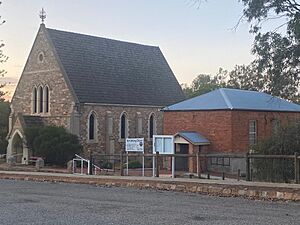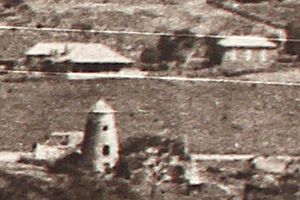Uniting Church, York, Western Australia facts for kids
Quick facts for kids Uniting Church, York |
|
|---|---|
| York Uniting Church | |

Uniting Church and chapel
|
|
| 31°53′12.649″S 116°45′59.216″E / 31.88684694°S 116.76644889°E | |
| Country | Australia |
| Denomination | Uniting (since 1977) |
| Previous denomination | Methodist (1888 – 1977) |
| History | |
| Former name(s) | Wesleyan Church |
| Status | Church |
| Founded | 25 April 1888 |
| Founder(s) | Mrs J H Monger |
| Dedicated | 22 August 1888 by Rev. Thomas Bird |
| Architecture | |
| Architect(s) | Alfred McBain Bonython |
| Architectural type | Church |
| Style | Gothic Revival |
| Administration | |
| Synod | Western Australia |
The Uniting Church, York is a historic church building in Grey Street, York, Western Australia. It was first built by the Methodist Church in 1888. Back then, it was known as the Wesleyan Church. This church and its older chapel are important early buildings in the town of York. Since 1977, it has been part of the Uniting Church.
Contents
The First Chapel: A Place to Gather
The first pastor in York was Reverend John Smithies. He also started the Gerald Mission. While he was in York, plans were made to build a "Wesleyan chapel." This happened on March 29, 1853. John Henry Monger Snr, a local businessman, managed the building plans. He lived next door at Faversham House and likely designed the chapel.
Monger asked for builders to offer prices for the work. He wanted a strong stone foundation, brick walls, and a roof with wooden shingles. The building was planned to be 40 feet long, 22 feet wide, and 10 feet high. Local people gave £200 to help pay for it, and the government also helped.
John Henry Monger Snr himself won the building contract. Construction went well, and the chapel was ready by August 1853. The roof was finished by George and John Wansbrough.
The chapel officially opened on April 5, 1854. Reverend William Lowe led the opening service for over 120 people. The total cost of the chapel was £317/12/4. This chapel was the second church ever built in York.
The chapel originally had a balcony inside, but it was later removed. In 1859, a harmonium (a type of organ) was bought for the chapel. People who attended paid a small fee to sit in the pews. This helped cover the costs of keeping the chapel running.
The chapel's design was simple and balanced. It followed the Victorian Georgian style.
Building the New Church
In August 1878, Reverend Thomas Bird arrived in York. He quickly saw that the old chapel was too small for the growing community. He started making plans for a new, larger church. The old chapel would then be used for Sunday School and other meetings.
In 1885, church leaders met to discuss building the new church. Many people in the Wesleyan community helped raise money. By March 1888, most of the money needed had been collected.
The building contract was given to Pringle and Moscrip from Perth and Adelaide. Their price was £945. Mrs J H Monger laid the foundation stone on April 25, 1888. The stone was a beautiful piece of Sydney sandstone. One of the builders, Mr Pringle, carved it and gave it as a gift.
A special ceremony was held for the foundation stone. The building site was decorated with flags. A sealed bottle was placed under the stone. It contained a list of church members and some coins from the colony. Joseph Pyke placed the bottle. Mr Pringle gave Mrs Monger a silver trowel for the ceremony. That evening, a concert was held to raise more money for the church. It was a success and added £17 to the building fund.
The church was expected to cost £1,000. In May 1888, there were worries because only £400 had been raised. Actually, only £236 had been collected at that point. John Henry Monger was the biggest donor, giving £59 in payments. Donations continued to come in, reaching £345.
People who supported the church also donated stone for the building. They even helped transport it to the site. By June, the church was almost finished. It was expected to be ready by the first Sunday in August 1888.
Opening Day of the Church
The last two services in the old chapel were held on August 19 by Reverend Thomas Bird and Reverend William Lowe. The new church officially opened on Wednesday, August 22, 1888. Reverend Thomas Bird led the first service at 3:45 pm.
The local newspaper, the Eastern Districts Chronicle, wrote about the opening. It said the church was a great addition to York's impressive buildings. The inside of the church was very well made. The sound quality inside was excellent. Many people came from Perth, Newcastle, Beverley, and other towns. About 300 people attended the opening service.
Church Architecture and Design
The architect who designed the church was Alfred McBain Bonython. He was only 23 years old at the time. He had moved from Adelaide and Melbourne to Perth. He also designed other Wesleyan Methodist churches in Fremantle and Albany.
The church is built in the Victorian Academic Gothic Revival style. This style often includes a steeply sloped roof and strong stone walls. It has features like wall supports called buttresses and tall, narrow windows called lancet windows. The porch, which has a pointed Gothic arch, was added later.
The Church Organ
In 1895, Mrs Florence Monger started a fund to buy a new organ. The organ was built by Alfred Monk of London. This organ is very special. It is one of only two Alfred Monk organs in Australia. Many people consider it the best 19th-century organ in Western Australia. It is known for its warm, bright sound that can fill the entire church.
When it was first installed, the organ needed someone to pump it by hand. An organ pumper had to make sure the air flow was steady. If the music was loud, they had to pump faster to keep enough air moving. The names of some of the people who pumped the organ are scratched into the back of the organ case.
In 1925, an electric blower was installed. This meant no more hand-pumping! The organ was repaired in 1981-82 and cleaned again in 2001.
The church originally planned for the choir to sit in a balcony. However, when the large pipe organ was installed, the choir moved to the front of the church instead.
The Church Bell
The church bell was made in London in 1905 by John Warner & Sons. It is about 510 millimeters (20 inches) wide. The bell weighs around 91 kilograms (200 pounds). Mr E. R. Parker donated the bell to the church.
The bell was first placed on a wooden tower behind the old chapel. When that tower became unsafe, it was replaced with a metal one. In November 2010, the bell was moved to its current tower. This new tower was paid for by donations from the public.


